当前位置:网站首页>16. Memory usage and segmentation
16. Memory usage and segmentation
2022-07-04 12:39:00 【PacosonSWJTU】
【README】
1. The content of this paper is summarized from B standing 《 operating system - Li Zhijun, teacher of Harbin Institute of technology 》, The content is great , Wall crack recommendation ;
【1】 Memory usage
【1.1】 The program is loaded into memory
1) Memory usage : Put the program in memory ,PC The register points to the start address ;
2) Load the program into memory ;
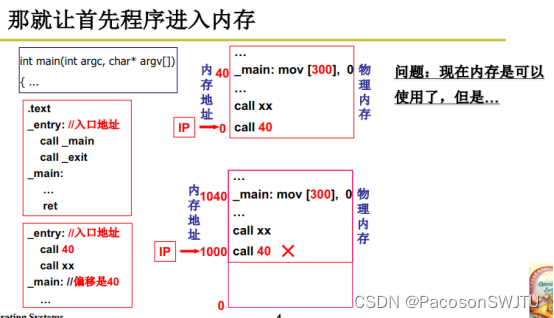
【 The illustration 】
- _entry The address of the entry program is 0;
- Call 40 Indicates that the call offset is 40 Function of ;
problem :
- The above code is stored on disk ; After loading into memory ,call 40 If the call offset is 40 The function of is problematic , Because the operating system program in memory from 0 Address start , therefore call 40 Call will report an error ;
resolvent :
- call 40 Medium 40 It's the relative address , Need to change to call entry Base address +40, Such as entry The base address is 1000, Then change to call 1040 ( The above operation of modifying the memory address in the program is called relocation );
3) The process of loading a program into memory
Need to find a free memory , Its base address is A, Load the program on the disk into this memory , Execute relocation to modify the memory address in the program ( The specific method of relocation is to add all memory offsets in the loaded program to the base address of free memory A);
Then the program fetches and executes , The program runs normally , Memory is also used smoothly ;
4) When to complete the relocation ?
- 1. Compile time : For embedded systems, relocation can be completed at compile time , But not flexible ;
- 2. Onload : When the program is loaded into memory , More flexible ( Non embedded systems generally use load time relocation ); Such as when the program is loaded from disk to memory , Memory address in the program ( Address offset ) Add the base address of the program ;
4.1) Relocation advantages and disadvantages :
- The program relocated at compile time can only be placed in a fixed location in memory ( rigid , When compiling, you need to determine the base address of the free memory storing the program );
- Once the program relocates during loading is loaded into memory, it cannot move ( flexible , When loading, the base address of the free memory storing the program is determined );
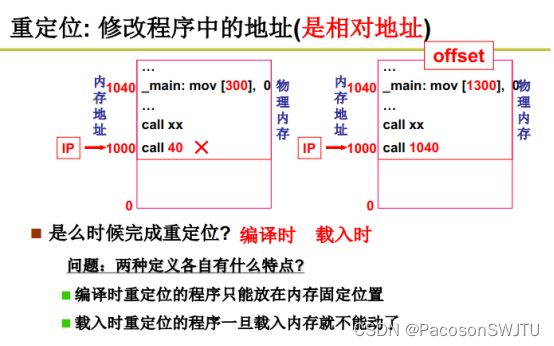
Add :
- Add 1:40 Is the logical memory address , Is the memory relative address , and 1040 Is the physical memory address , Is the absolute address of memory ;
- Add 2: Whether relocating at compile time or relocating at load time , Once the relocation operation , The memory address offset of program instruction operation cannot be modified ;
- This introduces new problems : Many times, after the program is loaded into memory , It will still move ; That is, the business scenario is when the program is running , The memory address offset of its operation needs to change ; Such as the swap in and swap out operation of the memory page where the program is located ;
5) An important concept : In exchange for swap
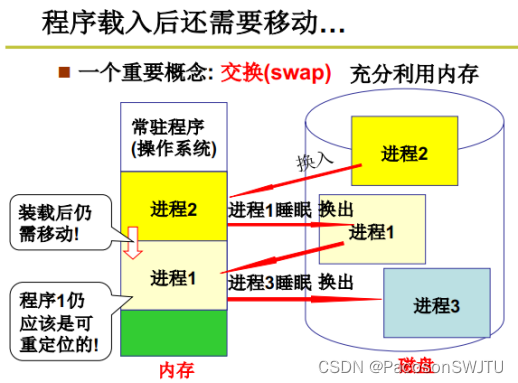
Initial state :
memory base address | Memory loaded process | Disk storage process |
2000 | process 2 | process 3 |
1000 | process 1 |
The first 1 Time Swap after :
memory base address | Memory loaded process | Disk storage process |
2000 | process 2 | process 1 |
1000 | process 3 |
The first 2 Time Swap after :
memory base address | Memory loaded process | Disk storage process |
2000 | process 1 | process 2 |
1000 | process 3 |
Swap It means :
- Small memory space , Big disk space . When the memory cannot hold the process 3 when , Will first put the process 1 Change out to disk , Then put the process on the disk 3 Switch into memory ;
- In short swap It refers to the operation that the process switches in and out between memory and disk ;
- Alignment process 1 Multiple exchange out and exchange in operations , Its memory address ( Or base address ) It's bound to change , This will cause the inland address of program instruction operation to change , Therefore, relocating at compile time or load time will lead to swap Process execution error after ;
So it should be runtime relocation , Instead of relocating at compile time or load time ;
【1.2】 Runtime relocation
1) Runtime relocation definitions : refer to Only when executing instructions , Add the memory offset of the instruction to the base address to get the memory address of the operand ; No matter how many times it is done swap, The inland addresses relocated at runtime are all correct ;
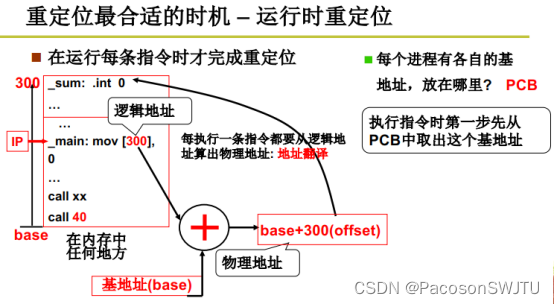
2) Address translation ( Also called relocation ):
- Runtime relocation , Also called address translation ; The physical address must be calculated from the logical address for each instruction executed ;
- Every time swap after , The memory base address of the process will be modified , Modified memory base address base Stored in the process structure PCB Inside ; That is, the process in the initial state 1 Of base be equal to 1000, The first 2 Time swap Post process 1 Of base be equal to 2000; In this way, the absolute physical address corresponding to the memory address offset in the instruction can be calculated correctly ;
- Add : When the process is running ,pcb The base address of the process stored in base It will be sent to the base register for storage , For subsequent calculation ;
3) Summary : How the program uses memory ?
- step 1: Find a free memory in memory , And locate the base address base( The starting address of this free memory ), And send it into the process pcb For storage ;
- step 2: Put the program into the step 1 In the requested free memory , With base Is the starting address ;
- step 3: When process scheduling or context switching ,pcb Inside base The base address will be sent to the base register for storage ;
- step 4: Every time an instruction is executed , Address translation ( relocation ), That is, add the memory address offset to the base address base Get the actual physical memory address , This physical memory address either stores program instructions or program operands ;
Go through the above steps , The program is executed ;
【 example 】 Multi process execution time base address switching
- step 1: Initial state , process 1 The base site of 2000, process 2 The base site of 1000;
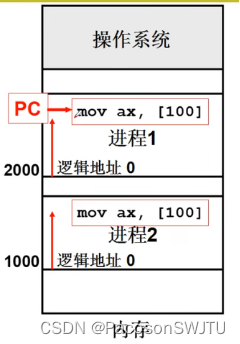
- step 2:cpu Execution process 1, process 1 Of pcb Base address of storage 2000 Send to the base register ;PC Register addressing to instruction mov ax,[100] And send it to IR register ;
- step 3: Execution instruction mov ax,[100] when , hold 100 Offset and base address 2000 Add to get the physical memory address of the operand ( Base addressing );
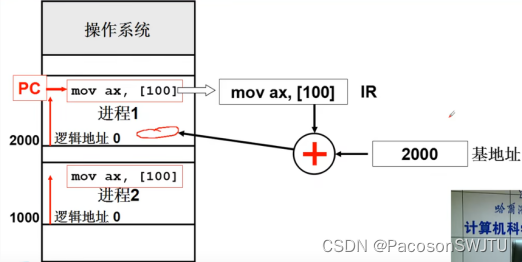
- step 4:cpu From process 1 Switch to process 2 (switch);
- After switching , process 2 Of pcb Stored base address 1000 Send to the base register ; In this way, the base address of the operand address of the subsequent instructions is modified to 1000 了 , After process switching The logical address can be correctly translated into the purpose of physical address ;
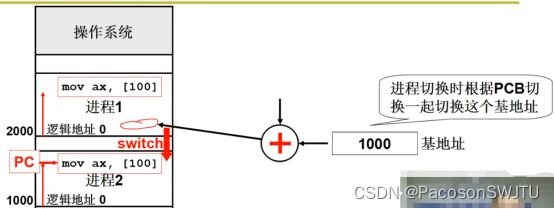
【2】 Memory segmentation
1) A program consists of several parts ( paragraph ) form , Each paragraph has its own characteristics , Such as main program , Variable sets , function library , The dynamic array , Stack, etc. ;
2) The memory address offset of the program in each part or segment is the relative address relative to the segment base address of the segment ;
3) How to locate specific instructions or data : < Segment number , Offset within segment >
【 example 】mov [es:bx], ax
We need to put es Is the base address of the segment ,bx Translate the logical address of the offset into the physical memory address ;
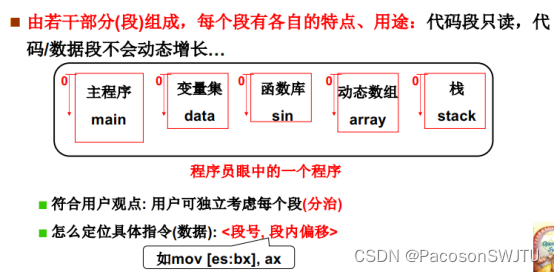
4) The benefits of program segmentation for storage ( Segmented storage adopts Divide and conquer thoughts )
- benefits 1: Instead of putting the whole program into memory , Instead, put each segment into memory separately , Improve memory utilization ;
- benefits 2: Doing it swap when , Not to switch the whole process in or out , Instead, a segment of the process is swapped in or out , Improved swap efficiency ; And reduced swap frequency ;
- benefits 3: Program segments or code segments are read-only ;( Variable sets ) Data segments are writable ; Segmented storage can avoid the scenario of code being written by mistake ;
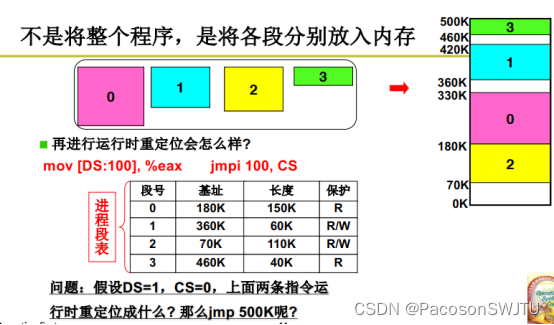
5) After the program is stored in sections , Each segment has its own base address ;
So the process pcb It is necessary to store the segment base address of multiple segments of the corresponding program ; As shown in the process segment table :
surface 1 Process segment table
Segment number | Base address | length | Protect |
0 | 180K | 150K | R |
1 | 360K | 60K | R/W |
2 | 70K | 110K | R/W |
3 | 460K | 40K | R |
Add : paragraph 0 The offset 30 And segment 1 The offset 30 The translated physical memory address is different , Because their base sites are different ;
6)GDT And LDT
You can think of the operating system as a process , The corresponding segment table is called GDT, The structure is the same as that in table 1 similar ;
Each process also has its own segment table ( Used to store the base address of multiple segments of the program ), As shown in the table 1 Shown , The corresponding structure is LDT;
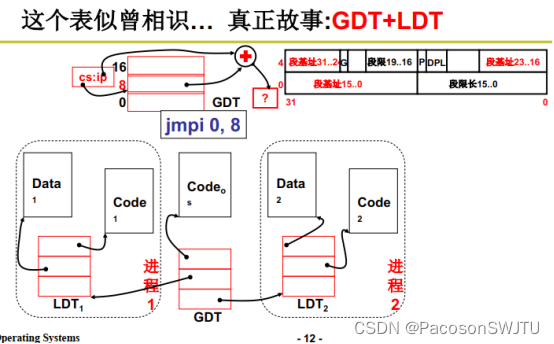
Summary : Steps to use memory in case of program segmentation ;
- step 1: Divide the program into segments , Including code snippets , Data segments, etc ;
- step 2: Each segment finds a free memory in memory , And put the base address of this section of memory ( Initial address ) Send in LDT Table is stored ( As shown in the table 1 structure );LDT The table stores the segment base addresses of multiple segments of the program ;
- step 3: hold LDT The table is assigned to the corresponding process PCB; At this point, the program has been loaded into memory ;
- Last :PC Register according to pcb Set the initial value , Fetch execution fetch execution , Every time an instruction is executed , All query LDT Table finds the segment base address , Add the base address of this segment to the address offset to get the physical memory address , For subsequent addressing operations ;
- Add : ldt The base address of the table is sent ldtr register ;
【 example 】 Address translation based on segment base address
1) process 1 Of LDT Table data
Segment number | Section base address |
1 | 1000 |
0 | 3000 |
2) process 2 Of LDT Table data
Segment number | Section base address |
1 | 7000 |
0 | 5000 |
3) Instructions
- process 1 Of mov [cs:40], ax, among cs The value of the code segment register is 0, From ldt The addressing subscript is 0 Section base address of (3000); therefore cs:40 The physical address obtained is 3000+40=3040;
- process 2 Of mov [cs:40], ax, among cs The value of the code segment register is 0, From ldt The addressing subscript is 0 Section base address of (5000); therefore cs:40 The physical address obtained is 5000+40=5040;
Because when cpu From process 1 Switch to process 2 when , First pcb from pcb1 Switch to pcb2, therefore pcb Stored ldt The base address will also be switched to ldt2 And send it to ldtr Register storage ;
So once ldtr Given a new value , Then the segment base address will be transferred from the process 1 Change to process 2 Section base address of , Achieve the purpose of multi process switching operation ;
边栏推荐
- [data clustering] section 3 of Chapter 4: DBSCAN performance analysis, advantages and disadvantages, and parameter selection methods
- MYCAT middleware installation and use
- queue
- Uva536 binary tree reconstruction tree recovery
- Unity performance optimization reading notes - explore performance issues -profiler (2.1)
- C language: find the palindrome number whose 100-999 is a multiple of 7
- JD home programmers delete databases and run away. Talk about binlog, the killer of MySQL data backup
- Global and Chinese markets of digital PCR and real-time PCR 2022-2028: Research Report on technology, participants, trends, market size and share
- [Yunju entrepreneurial foundation notes] Chapter II entrepreneur test 22
- MySQL advanced review
猜你喜欢
![Entitas learning [iv] other common knowledge points](/img/1c/f899f4600fef07ce39189e16afc44a.jpg)
Entitas learning [iv] other common knowledge points
![[Yunju entrepreneurial foundation notes] Chapter II entrepreneur test 24](/img/2e/b1f348ee6abaef24b439944acf36d8.jpg)
[Yunju entrepreneurial foundation notes] Chapter II entrepreneur test 24
![Entitas learning [3] multi context system](/img/f9/a3ce86ff2121dd1043305b7e834cc5.jpg)
Entitas learning [3] multi context system
![[Yunju entrepreneurial foundation notes] Chapter II entrepreneur test 16](/img/c3/f3746b161012acc3751b2bd0b8f663.jpg)
[Yunju entrepreneurial foundation notes] Chapter II entrepreneur test 16
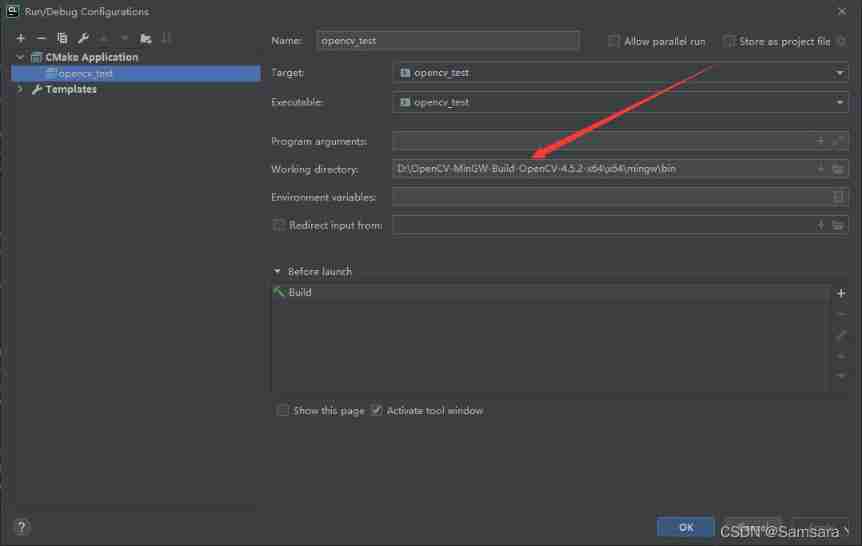
Clion configuration of opencv

Review of week 278 of leetcode II
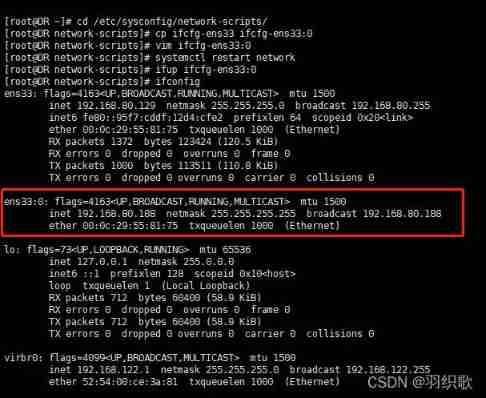
LVS load balancing cluster deployment - Dr direct routing mode
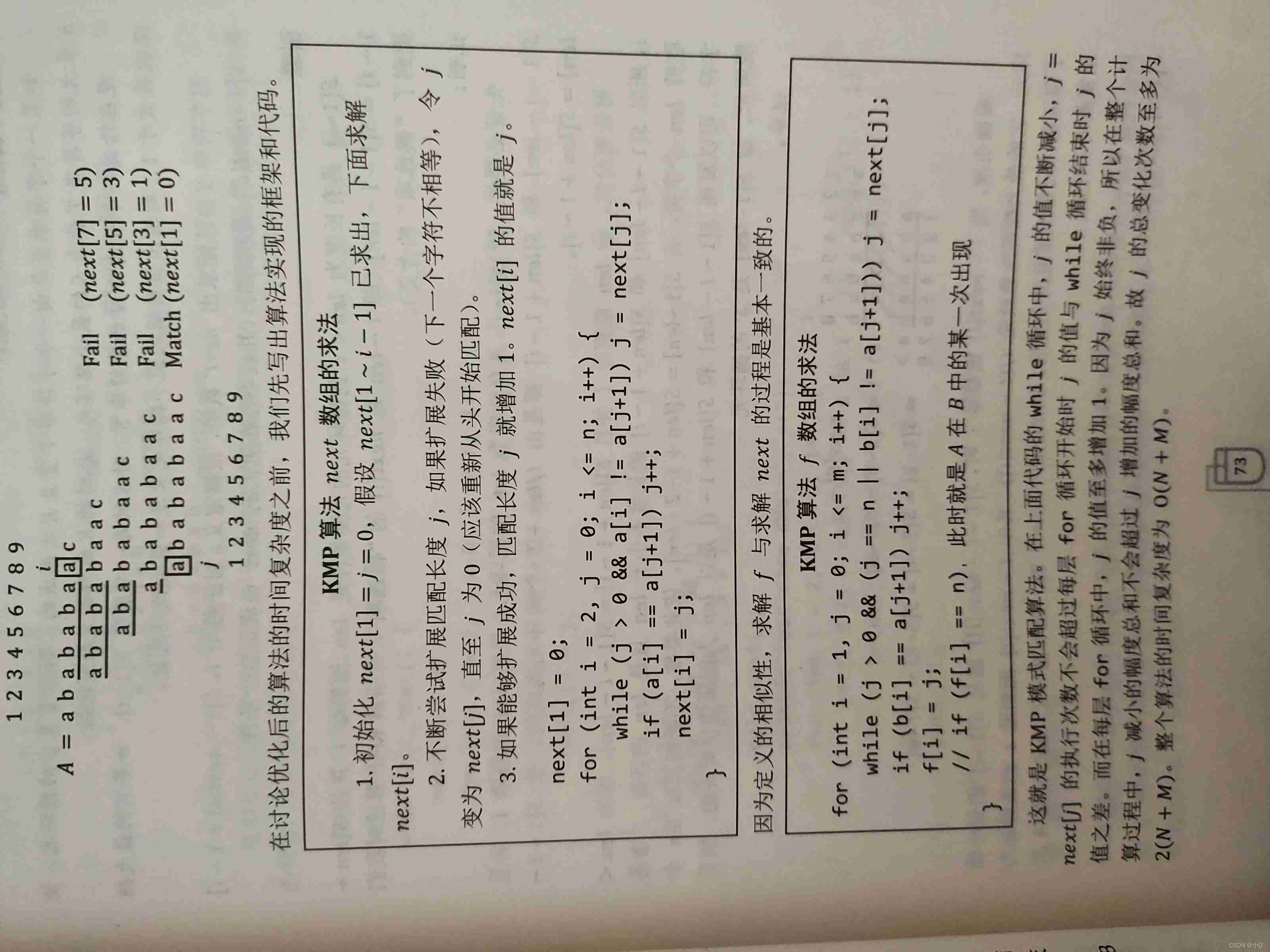
0x15 string
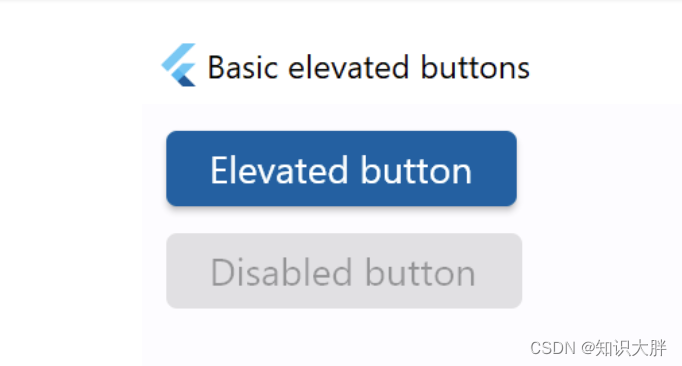
Flet教程之 按钮控件 ElevatedButton入门(教程含源码)

Star leap plan | new projects are continuously being recruited! MSR Asia MSR Redmond joint research program invites you to apply!
随机推荐
Unity performance optimization reading notes - Introduction (1)
priority_ queue
Globalsign's SSL certificate products
Exness: positive I win, negative you lose
Entitas learning [iv] other common knowledge points
16.内存使用与分段
ASP. Net razor – introduction to VB loops and arrays
DVC use case (VI): Data Registry
Show recent errors only command /bin/sh failed with exit code 1
01. Basics - MySQL overview
C language: find the length of string
The detailed installation process of Ninja security penetration system (Ninjitsu OS V3). Both old and new VM versions can be installed through personal testing, with download sources
Lvs+kept highly available cluster
[Yunju entrepreneurial foundation notes] Chapter II entrepreneur test 13
[data clustering] section 3 of Chapter 4: DBSCAN performance analysis, advantages and disadvantages, and parameter selection methods
The solution of permission denied
Unity performance optimization reading notes - explore performance issues -profiler (2.1)
It's hard to hear C language? Why don't you take a look at this (V) pointer
[Yunju entrepreneurial foundation notes] Chapter II entrepreneur test 18
[Yu Yue education] 233 pre school children's language education reference questions in the spring of 2019 of the National Open University